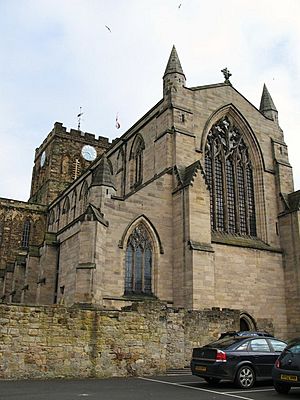Acca of Hexham facts for kids
Quick facts for kids SaintAcca of Hexham |
|
|---|---|

Hexham Abbey
|
|
| Abbot & Bishop | |
| Born | c. 660 |
| Died | 740 or 742 |
| Venerated in | Roman Catholicism; Anglicanism; Eastern Orthodoxy |
| Major shrine | Hexham Abbey, Northumberland (part of his cross survives) |
| Feast | 20 October |
Acca of Hexham (born around 660 – died 740 or 742) was an important church leader in early medieval Northumbria, a kingdom in what is now northern England. He served as the bishop of Hexham from 709 to 732. After his death, he became known as a Christian saint.
Contents
Acca's Early Life and Journeys

Acca was born in Northumbria. When he was young, he worked for Bosa of York, who later became the Bishop of York.
Later, Acca joined Wilfrid, another important church leader. This might have been as early as 678. Acca traveled with Wilfrid on his many journeys.
Acca once told his friend, the famous historian Bede, about their visit to Utrecht. There, they met Archbishop Willibrord, who was a former student of Wilfrid. Willibrord was busy converting people in Europe to Christianity.
Becoming a Leader at Hexham
In 692, after their second trip to Rome, Wilfrid returned to Hexham. He made Acca the abbot of St Andrew's monastery there.
Acca was a very loyal friend to Wilfrid, especially in Wilfrid's later years. When Wilfrid died in 709, Acca took over his roles as both abbot and bishop.
Acca's Work as Bishop
Acca was very energetic in his new duties. He worked hard to manage the diocese, which is the area a bishop is responsible for. He also made sure church services were well-organized.
He continued the important work of building and decorating churches that Wilfrid had started. Acca was also a talented musician and a very knowledgeable theologian. A theologian is someone who studies religious beliefs.
Bede described Acca as "a most experienced cantor" (a church singer). He also said Acca was "most learned in sacred writings" and knew "the rules of ecclesiastical custom" very well. This means Acca understood church traditions deeply.
Acca even brought a famous singer named Maban to Northumbria. Maban had learned the Roman way of singing psalmody (church songs) in Kent. This style came from Pope Gregory the Great through Augustine of Canterbury.
Acca's Love for Learning
Acca was also famous for his deep knowledge of theology. Bede praised Acca's theological library, calling it "large and most noble."
Acca was known for encouraging students to learn in every way he could. It was Acca who convinced Stephen of Ripon to write the Life of Saint Wilfrid, which is a biography of Wilfrid.
Acca also lent many important materials to Bede for his famous book, the Historia ecclesiastica gentis Anglorum (Ecclesiastical History of the English People). Bede dedicated several of his most important works, especially those about the Bible, to Acca.
Later Years and Legacy
For reasons we don't know today, Acca either left or was made to leave his diocese in 732.
Some stories say he became the bishop of Whithorn in Galloway, Scotland. Others claim he started a new church center in St Andrews. They say he brought holy objects, called relics, that he had collected on his trip to Rome, including some from St Andrew.
Another story suggests that Acca had an argument with the Northumbrian king. This led him to live in exile in Ireland before returning to Hexham. The church of St Andrew in Aycliffe Village is said to have once been dedicated to Acca.
Acca was buried at Hexham, near the east wall of the abbey. Two beautifully carved crosses were placed at the head and foot of his grave. Fragments of one of these crosses still exist today.
People began to respect Acca as a saint right after he died. His body was moved at least three times over the centuries. His feast day, which is a day to celebrate him, is 20 October. The day his relics were moved is remembered on 19 February.
The only writing by Acca that still exists is a letter he wrote to Bede. This letter is included in Bede's collected works.

